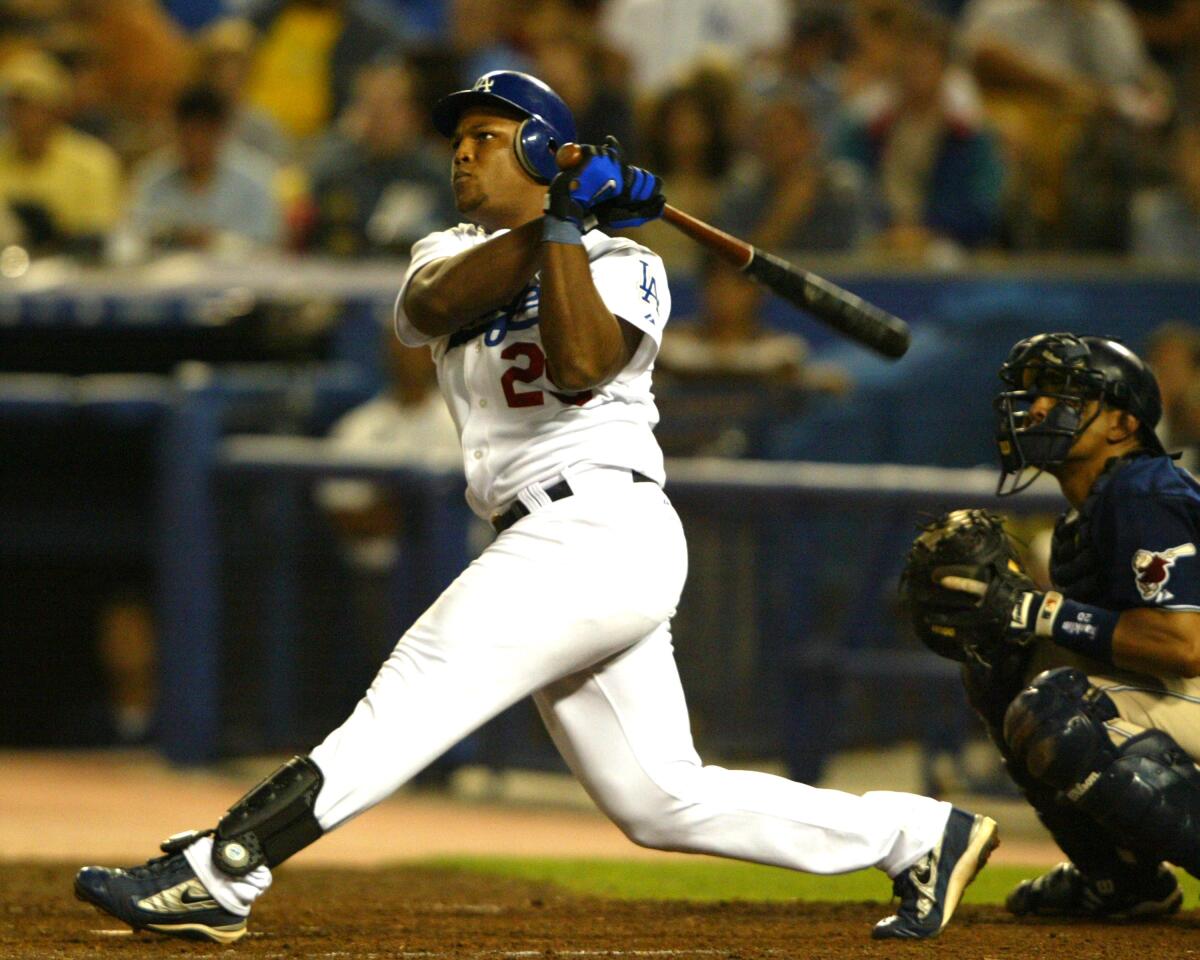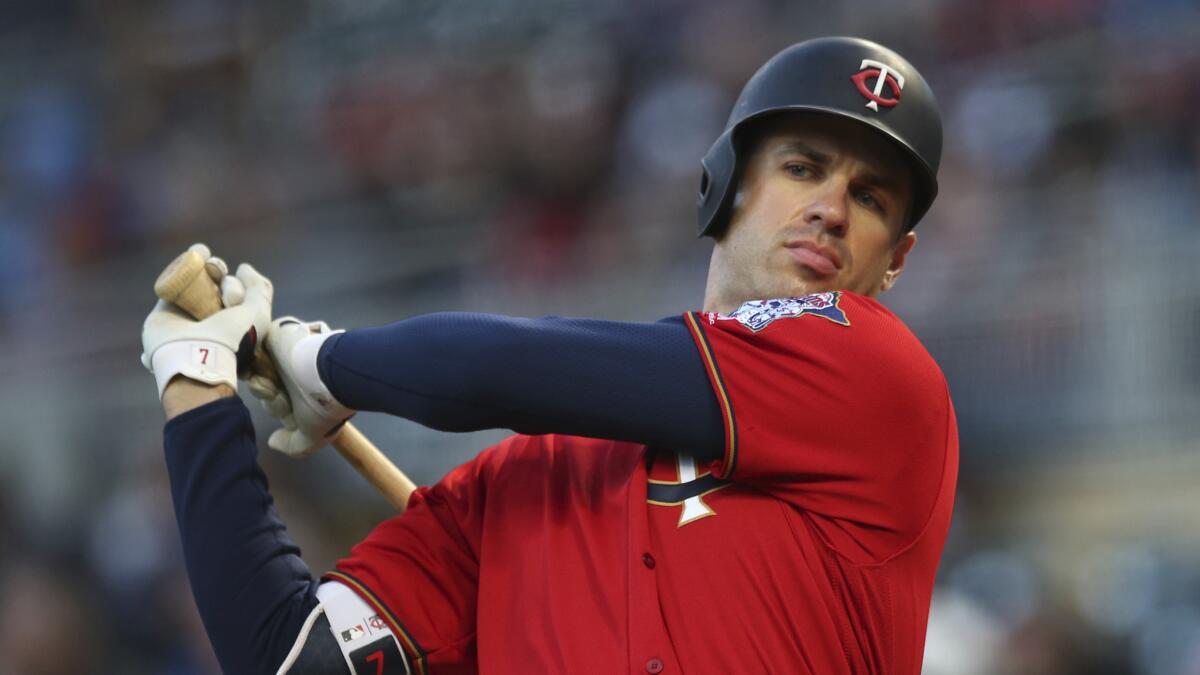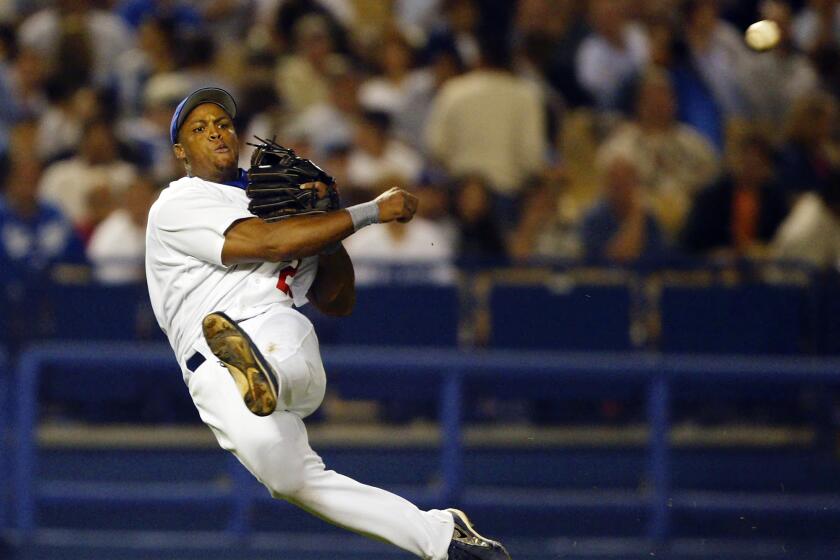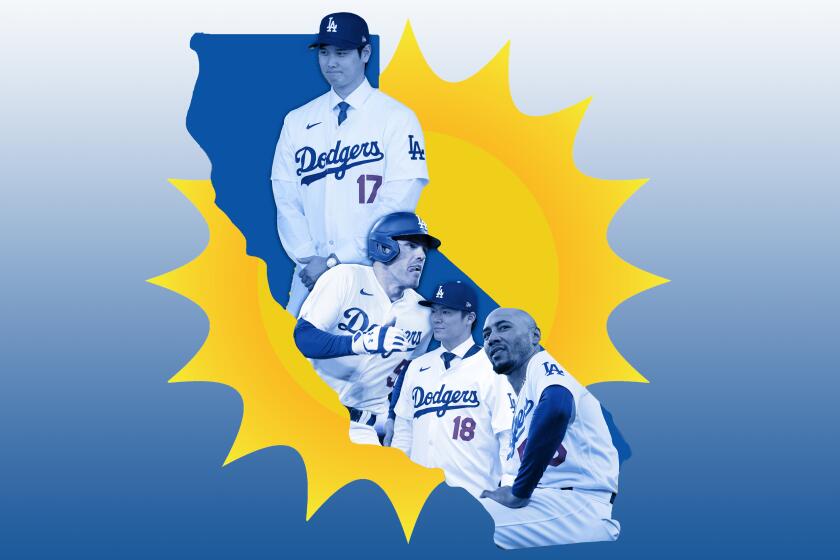How an ankle injury helped a young Adrián Beltré become a Hall of Famer

- Share via
Adrián Beltré was considered a teenage prodigy when he signed with the Dodgers for $23,000 in 1994, but there was little about his early career, marred by a birth-certificate issue and his slow recovery from a botched appendectomy in the Dominican Republic, which screamed “surefire Hall-of-Famer.”
Beltré was a good-but-not-yet-great player during his first five big league seasons in Los Angeles, where he hit .262 with a .748 on-base-plus-slugging percentage and averaged just 16 homers and 65 RBIs a season from 1999 to 2003.
The Dodgers nearly lost Beltré to free agency in 2000 when a Major League Baseball investigation found they had signed him before his 16th birthday, and Beltré sat out the first six weeks of 2001 after undergoing surgery to close a wound in his large intestine, the result of an infection from an emergency appendectomy that January.
Adrián Beltré will be a first-ballot Hall of Famer. But neither Beltré nor seven other former Dodgers on the ballot would wear an L.A. cap if inducted.
Beltré suffered another setback in 2004, playing most of the season with bone spurs in his left ankle that were so painful he limped noticeably around the bases on many of the 48 home runs he hit for the Dodgers and needed surgery in October to remove them.
But in the eyes of former Dodgers teammate Shawn Green, that nagging foot injury might have helped spur Beltré’s transformation from promising young third baseman to potential Hall-of-Famer.
“He was kind of a wild horse at that point, where he just wanted to run,” Green said of Beltré, who was 25 and in his seventh big league season in 2004. “That injury to his front foot kind of slowed him down, and that’s kind of when he started to figure things out and realize that he could be patient at the plate. He didn’t jump at the ball as much.”
Of Beltré’s many quirks — his aversion to being touched on the head, the home runs he’d hit off one knee, the flat-footed bullets he would fire to first base — one that didn’t serve him well early in his career was the happy-feet shuffle he’d do in the batter’s box.
But the bone spurs forced Beltré to quiet his lower half, and the contact he generated grew consistently louder, producing a breakout 2004 season in which Beltré hit .348 with a 1.017 OPS, 121 RBIs and 104 runs to go with those 48 homers — all career highs — and finished second in National League most valuable player voting.
Beltré went on to play 14 more years with the Seattle Mariners, Boston Red Sox and Texas Rangers, amassing 3,166 hits, 477 homers and 1,707 RBIs, five Gold Gloves and four All-Star selections in his 21-year career, and on Tuesday, writers made him a first-ballot selection into the National Baseball Hall of Fame.
Beltré was named on 366 of 385 ballots (95.1%) of Baseball Writers Assn. of America members and will be joined in the July 21 induction ceremony by former Minnesota Twins catcher Joe Mauer, who was also a first-ballot selection, and former Colorado Rockies first baseman Todd Helton, who made it on his sixth try on the ballot.
Beltré, who is expected to wear a Rangers cap on his Hall-of-Fame plaque, will be the third inductee in 10 years to start his career with the Dodgers and be enshrined with another team, joining Pedro Martinez in 2015 and Mike Piazza in 2016. The last player to reach Cooperstown as a Dodger was Don Sutton in 1998.

And to think, Beltré might not have achieved such heights if not for that bum ankle in 2004.
“It’s like the stars were aligned,” said Green, a Dodgers first baseman and outfielder from 2000 to 2004. “It’s almost the perfect injury for a lot of young players, because that’s the hardest thing for a hitter, to slow your feet down. You get antsy at the plate, you dive into the ball and stride a little too quickly. But that injury just slowed everything down.
“He got off to a fast start and got moved into the heart of the lineup. After a couple of years where people were kind of questioning whether he was going to be that middle-of-the-order guy, it got to the point where everyone believed in him, and I think that was a big boost.”
The Dodgers were unable to retain their budding star as a free agent after that monster 2004 season, Beltré departing to sign a five-year, $64-million deal with the Mariners.
The expansive outfield dimensions of pitcher-friendly Safeco Field and the pressure to live up to his big contract did not seem to suit Beltré, who hit .266 with a .759 OPS and averaged 21 homers and 79 RBIs in five seasons in Seattle in which he failed to earn an All-Star selection or lead the Mariners to the playoffs.
Beltré signed a one-year, $9-million “pillow contract” with the Red Sox in 2010 and reestablished himself as a force at the plate, batting .321 with a .919 OPS, 28 homers and 102 RBIs and pelting Fenway Park’s Green Monster with many of his career-high 49 doubles.
Beltré parlayed that bounce-back season into a six-year, $96-million deal with the Rangers and was dominant in Texas, batting .308 with an .873 OPS and averaging 28 homers and 94 RBIs a season from 2011 to 2016. He finished among the top seven MVP vote-getters three times and won three Gold Gloves.
Beltré hit .296 with an .892 OPS, 32 homers and 105 RBIs in 2011 to help push the Rangers to within one strike of what would have been their first championship before the St. Louis Cardinals rallied to win Game 6 of the World Series in 11 innings and a decisive Game 7.
“He was a brilliant defender with power, a really good baseball player, but it wasn’t until I played with him that I really understood how truly great the guy is,” Michael Young, a Rangers infielder from 2001 to 2012, said of Beltré, who retired after 2018.
“All the things I thought about him playing through injuries and being able to focus when he wasn’t 100%, those were real and true and exactly as I thought as an opponent. But then I would see the preparation and the attention to detail and the intensity and competitiveness, and you immediately fall in love with the guy as a teammate.”
The 5-foot-11, 220-pound Beltré was thick for a third baseman, but he had quick feet, soft hands, a strong and accurate arm, and he rivaled Hall of Famer Brooks Robinson’s ability to charge slow rollers and make off-balance throws to first.
The Dodgers can sell fans on excitement and winning. The other California teams? Not so much.
Beltré accumulated 200 defensive runs saved in his career, according to Fangraphs, more than any other third baseman in major league history.
“Adrián wasn’t the fastest guy on the field, but he was one of the quickest and most agile,” Young said. “When you talk about everything a third baseman has to do ... he had great hands, great body awareness, took perfect angles, moved to his left and right and came in on the ball as well as anyone.”
And he did it all with a smile that was as infectious as his bat was lethal, Beltré’s effervescent personality rubbing off on just about every teammate — especially longtime Rangers shortstop Elvis Andrus, whom he mentored and joked around with for a solid decade — that he ever played with.
“Everyone who watched Adrián Beltré play baseball could tell he was having fun, but he towed that line perfectly,” Young said. “He had a blast playing the sport he loved, but at the same time, there wasn’t anybody who was more competitive or more intense. When it’s winning time, when it’s go time, he’s the guy you want on your side.”
More to Read
Are you a true-blue fan?
Get our Dodgers Dugout newsletter for insights, news and much more.
You may occasionally receive promotional content from the Los Angeles Times.












